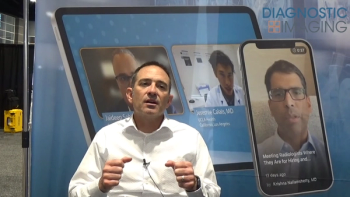
Esaote prepares to launch tilting MR scanner in Europe
A new dedicated MR scanner is expected to arrive in February. Esaote’s G-Scan, featuring a tilting table that takes the patient from supine to standing, is being prepped to enter the European market. The company, a member of the Bracco group based in Genoa, Italy, will bring the system to the U.S., but not in the near future.
A new dedicated MR scanner is expected to arrive in February. Esaote's G-Scan, featuring a tilting table that takes the patient from supine to standing, is being prepped to enter the European market. The company, a member of the Bracco group based in Genoa, Italy, will bring the system to the U.S., but not in the near future.
The first deliveries are slated for European sites, probably Italy and possibly Germany. Esaote wants to keep these first units close to home, as it ramps up production.
"Staying near our factory will help us in developing applications and in other system development," said Wim van Kemenade, marketing and sales manager for the Esaote MRI Division. "In the next phase, we will go to the U.S."
G-Scan's tilting table allows scans not only in conventional but also in weight-bearing positions, which facilitates musculoskeletal applications. It can also perform some extremity scanning. The head is not covered.
"In theory you could do the head, but we haven't developed the software," he said.
The new product, which cleared the FDA in October and was showcased at the RSNA meeting, is designed primarily to image the spine. Other Esaote products cannot do the spine. The company's E-Scan XQ, C-Scan, and ArtoScan-M are dedicated to extremity imaging.
"The G-Scan is the next logical step from the E-Scan and C-Scan," van Kemenade said. "The only thing missing was musculoskeletal MRI."
G-Scan will sell for about €650,000 ($855,000). The company plans to sell it directly outside the U.S. No plans have yet been announced for the sale of G-Scan in the U.S. In the past, Esaote has worked with U.S. distributors to sell MR systems. It currently has an arrangement with GE Lunar to sell its C-Scan and E-Scan XQ.
With its ability to image patients in the weight-bearing position, G-Scan should be especially effective at doing orthopedic assessments. But it will not be sold just to orthopedists.
"It will be sold to anyone who has a substantial load of orthopedic imaging needs," he said.
The permanent magnet, which operates at 0.24T, requires just 20 m² (210 sq. ft.) to site. Pulse sequences include Turbo Spin Echo 7 along with others built into the E-Scan XQ.
The system stacks up well against one of the most popular open scanners: Hitachi's Airis II. G-Scan features a field-of-view from 100 to 350 mm compared with 50 to 350 mm on the Airis. The gantry opening is 33 cm, compared with 38 cm on the Hitachi scanner.
Newsletter
Stay at the forefront of radiology with the Diagnostic Imaging newsletter, delivering the latest news, clinical insights, and imaging advancements for today’s radiologists.




























